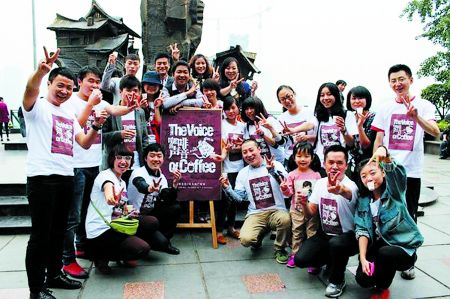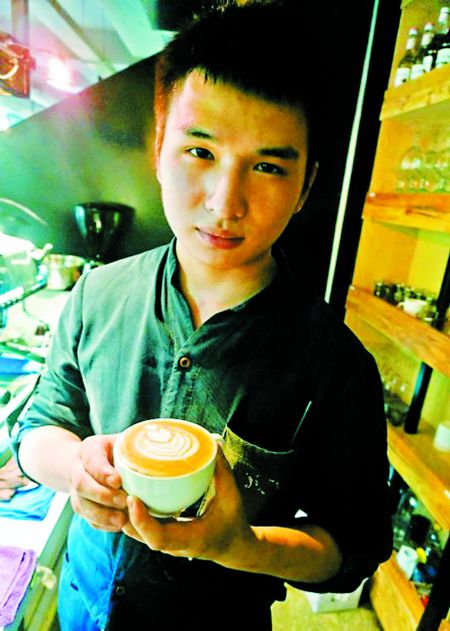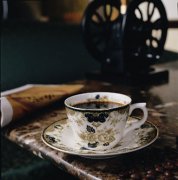A group of baristas love bitter taste, compete with each other and are more willing to share.

Coffee lovers take a group photo in Hongya Cave. This group of pictures are provided by interviewees.

Wang Xuechao and his coffee
Barista Jia Ming
Xiao Xiangdan, a reporter from the Business Daily
Drinking coffee is no stranger to urbanites. Behind the aroma of coffee, there is a group of people who make a living for coffee. There are similarities and differences between coffee and Chinese food, which can be divided into making (both talking about hot), (setting the plate) embellishment, and producing (sharing). There is a coffee circle in Chongqing, where there are coffee quality appraisers, coffee roasters, and coffee bouquets. They share their experiences in making coffee, and coffee shop owners will not be "looked down upon" when they visit each other.
Production: the craftsman's mind of making coffee
Zhang Ming is 29.
Coffee quality appraiser
The day before yesterday, the reporter came to a cafe in Shapingba. Zhang Ming was giving lessons to the students. In the circle, the nickname "can" is more familiar than "Zhang Ming".
Cans is from the northeast. The university studied architectural design in Melbourne, Australia. When he met the Australian champion of the barista contest in a working cafe, he began to like coffee. Seven years ago, he went to Chongqing to work on a project, and the enthusiasm of the Chongqing people made him feel that "this is a city that you can't leave once you come."
In 2010, he said, he wanted to make more friends in Chongqing and opened a coffee shop, which later became his main business. "you can't really like one thing too much," he jokes. soon after opening a coffee shop, he quit his job as an architect and concentrated on learning to be a barista, going to foreign websites or buying books to learn about coffee. The year before last, he went to Shanghai to apply for the SCAA (American Special Coffee Association) training course and obtained the certificate of coffee roaster and coffee quality appraiser (at present, there are more than 100 people in the country).
He said that coffee quality appraisers are similar to red wine appraisers, with a very sensitive sense of taste and smell, mostly by nature. But when he took the coffee quality appraiser, he drank 200,300 drinks of different acidity and salinity from 8am to 8pm every day for five days, distinguishing which level of acidity it was.
"canned" has its own understanding of coffee. He likens himself to a barista. "Coffee is a handicraft. As a drink for people to eat, it uses the mentality of craftsmen to make the quality of coffee." He sometimes goes to the place where coffee beans are produced to choose coffee beans, and after taking them back, he bakes them for 9 to 15 minutes. He says 70% of the quality of coffee comes from roasting, and he dares not slack off. In 2014, he won the highest score in the Chongqing station of the World Barista Competition. At present, the coffee studio he runs is also training teachers, recruiting 4-6 students per period, just like making coffee. He hopes that he can be responsible to the students.
Embellishment: zero foundation to pull flower master
Wang Xuechao is 24 years old
The sixth place in the 2014 National Coffee draw Competition
From raw beans to baking to grinding, this is a stage in which "cans" maintain quality with the mentality of craftsmen. In the second stage, coffee can also give people a sense of beauty as a drink, and the flower decoration embellishes the beauty of coffee.
Wang Xuechao, a 24-year-old native of Mianyang, won the sixth place in the National Coffee pull Competition this year. He hasn't been learning coffee for a long time, but he must be attentive. He came to Chongqing three years ago to study logistics at a coffee school, but he became a student because he took a peek at the coffee course.
Then he worked as a bartender in a cafe and practiced flower drawing for three or four hours outside of work every day. He says the coffee pull is a change made on the original cappuccino or latte. Vision is on the one hand, but it is still necessary to achieve the dense taste and integration of milk to achieve the overall color, aroma and taste of the state. He also said that the coffee flower is not the last process of coffee, the last process of coffee is presented to the guests.
Product: coffee is about sharing.
Jia Ming post-80s generation
Coffee training teacher
The meaning of coffee lies in sharing, which is the understanding of coffee by five baristas and the third stage of coffee. As for the core of Chongqing coffee circle, they think it is unity and willingness to share, and the central character is Jia Ming, nicknamed "Coffee semi-fairy".
This post-80s young man prefers to call himself a heavy lover of coffee. "if he only depends on coffee to support his family, his wife will definitely quarrel." He ridiculed that he is more concerned about the future of Chongqing cafes. After all, many cafes are closed every year for various reasons, and he hopes that there will be more exchanges in the future.
Jia Ming, a former coffee trainer, traveled from Chengdu to Chongqing in 2007. He wanted to do something for Chongqing Coffee. A month after arriving in Chongqing, instead of looking for a job, he soaked in the cafes in Chongqing and found that it was not as beautiful as he had imagined. Slowly, he worked in a western restaurant and began to hold some coffee-sharing parties. In 2012, he held more than 30 coffee-sharing activities in a row. "good coffee is not only bitter."
Current situation
There are 500 people in this coffee circle
Often drop by to share experience
Jia Ming said that at present, they are preparing for the Chongqing Fine Coffee Association, hoping that everyone can communicate and make healthier coffee, so that the cafes in Chongqing will move towards a better future. They are also collecting statistics on coffee workers in Chongqing. According to the data collected, there are about 80 cafes (excluding coffee shops and coffee shops) in Chongqing, and their coffee circle has about 500 people.
Jia Ming said that many people in the circle have cafes or studios, and many are outsiders, perhaps influenced by the enthusiasm and character of Chongqing people. Chongqing's coffee shop circle is developing healthily, and they are competitive, but they are still willing to share. Cans can speak English and learn that some foreign knowledge about coffee will also be shared with you. Barista Ami closed her shop that day to meet a coffee lover and led her to a cafe in the flower market or other places to experience it. It is common in the circle for the owner of a coffee shop to drink coffee in another coffee shop and will not be "looked down upon". From September 8 to 10 this year, a coffee shop in Chongqing hosted the Southwest Division Competition of the National Coffee Baking Masters, and people from major cafes also enthusiastically forwarded and signed up to participate. On the 10th, everyone sat down and held an experience-sharing meeting.
Small knowledge the world's leading baristas are SCAA and SCAE (European Special Coffee Association). Take SCAA as an example, you need to have a certain foundation before applying for training, and the cost ranges from 7, 000 to more than 10, 000 yuan. The pass rate of baristas is 80%-90%, and that of coffee roasters is 60%-70%. The highest pass rate of coffee quality appraisers is 20% and the lowest is 2%. Most of them depend on their natural sense of smell and taste. According to Zhang Ming, at present, there are more than 100 coffee experts certified by SCAA in the country.
Link
Coffee has gone through three stages.
The first wave: in the era of instant coffee before and after World War II (1940-1960), most people drank coffee with artificial sweeteners such as sugar packets, cream or cream.
The second wave: the boutique coffee era from 1960 to 2000, represented by Starbucks and dominated by heavy roasting, ignited the coffee trend represented by latte.
The third wave: the rise of coffee aesthetic era in 2000, with a single variety of manor beans, light and medium roasting, strong black coffee, and re-roasting out of favor, advocating scientific and healthy coffee.
Important Notice :
前街咖啡 FrontStreet Coffee has moved to new addredd:
FrontStreet Coffee Address: 315,Donghua East Road,GuangZhou
Tel:020 38364473
- Prev

From January to August 2014, the average export price of Vietnamese coffee dropped by 4.14% year-on-year
Vietnam's "Economic Times" reported on September 16: Vietnam Coffee Rubber Association said that Vietnam's coffee harvest season in 2013 and 2014 will end in half a month, and it is expected that the export volume of coffee will reach 1.59 million tons, and the export amount will reach 3.25 billion US dollars. In August 2014, Vietnam exported 1.22 million tons of coffee, with an export value of 2.53 billion US dollars, an increase of 26.8% year-on-year in export volume and an increase of 22.
- Next

Famous Coffee Limited Blue Mountain Coffee
Blue Mountain Coffee can maintain today's top status, but also with the local government's policy of limiting production and quality. Jamaica does not mass-produce Blue Mountain coffee regardless of quality because it is famous. Instead, quality was given priority, and it was better to sacrifice production and protect the gold-lettered signboard of Blue Mountain Coffee. Brazil, the world's largest coffee producer, produces 30 million bags (60 kg each) of coffee a year,
Related
- Why are the coffee in some coffee shops not enough after being frozen? What should I make up for my American latte cappuccino coffee after being frozen?
- How much water does it take to steam coffee by hand? Why is the coffee brewing and steaming time 30 seconds? What is the purpose of steaming coffee?
- The suspected drink contains too much caffeine! Overlord Tea Lady responds urgently!
- Starbucks rejects antique paper coupons?! Netizen: Missed marketing opportunities!
- What ratio of water temperature and ground does the smart cup method use to press coffee? The difference between brewed coffee and filtered coffee?
- What is the standard process for the purpose of coffee cup testing? What is the difference between hand-brewed coffee and cup testing?
- How to use hand-brewed coffee paragon small golden balls? How does cold coffee lock in the aroma of coffee?
- Is American coffee black? What is the difference between American coffee and drip coffee?
- Unexpected! Well-known tea beverage brand Lele Tea will withdraw from the Zhengzhou market!
- Starbucks enters the fashion and beauty industry?! Netizen: Give me an ice American eye cream

